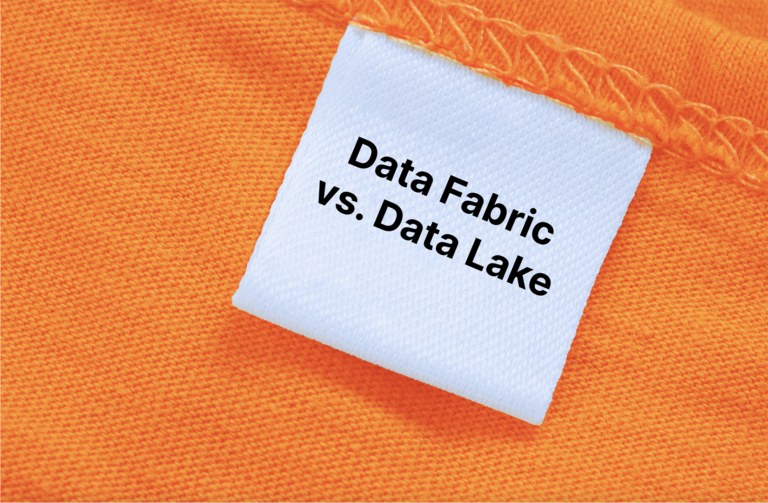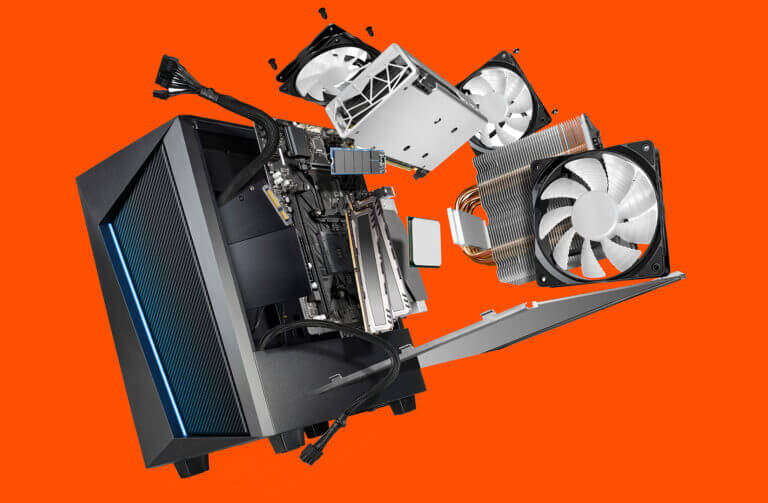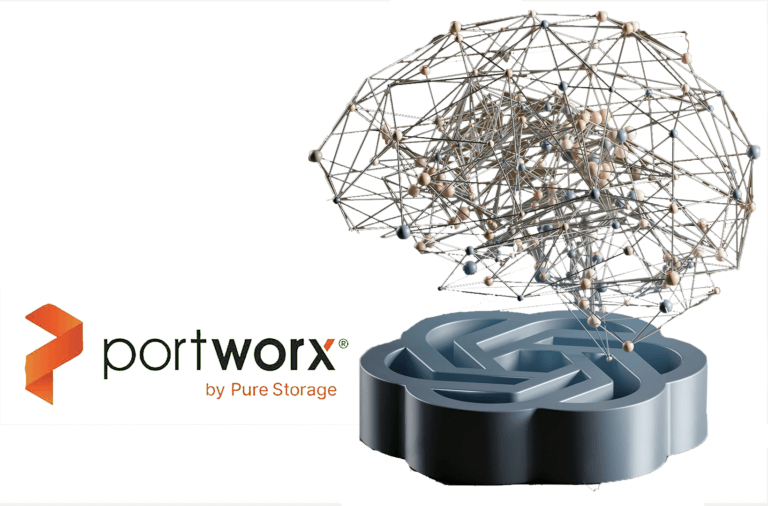As businesses collect more “raw” data—such as computer logs or video files that have not yet been processed, cleaned, or analyzed for use—they need reliable and effective ways to manage that information until they’re ready to work with it.
Two options for addressing large, raw data storage demands are data fabric and data lake solutions. Whether your organization uses one or both of these approaches depends on what you want to do with your data and who will need to access it in your organization.
To help inform your decision-making, here’s a closer look at the differences between the two, as well as another solution for storing data—a data warehouse.
What Is Data Fabric?
A data fabric is a type of data architecture in which data is provisioned through a unified integrated access layer available across an organization’s IT infrastructure. It provides a unified, real-time view of data, enabling businesses to integrate their data management processes with their data from various sources, including hybrid cloud environments, web applications, and edge devices.
While the data fabric approach makes data less siloed and available to more users, it can also help the business to maintain appropriate data access and governance restrictions—thereby enhancing data security and ensuring compliance with relevant regulatory requirements.
Features of Data Fabric
As a unified data management platform, a data fabric solution features services and technologies that enable processes such as data integration, governance, cataloging, discovery, orchestration, and more.
The architectural elements of data fabric include, but are not limited to, a data transport layer for moving data across the fabric and advanced algorithms for data analysis. Other components include application programming interfaces (APIs) and software development kits (SDKs) for making data and insights available to front-end users through tools they use to work with data—like those for business intelligence (BI), reporting, and visualization.
Advantages and Disadvantages of Using Data Fabric
Data fabric can bring together massive amounts of complex, diverse data from multiple sources, including data lakes and data warehouses. Data fabric isn’t just for collecting and storing data, however. Its architecture includes machine learning and analytics capabilities for transforming and processing data fast and at scale.
As Gartner explains, data fabric applies continuous analytics “over existing, discoverable and inferenced metadata assets” and “identifies and connects data from disparate applications to discover unique, business-relevant relationships between the available data points.”
A downside to using data fabric: While this approach is meant to help organizations gain a complete view of their data and use their data more effectively, implementing and maintaining a data fabric solution that is secure and integrates with all relevant data sources and platforms is a complex undertaking. It requires specialized skills and expertise—and thus, a healthy IT budget.
What Is a Data Lake?
A data lake is a centralized data storage environment capable of holding massive amounts of data (e.g., petabytes) in its raw form for eventual use in data processing. Data lakes can contain semi-structured, structured, and unstructured data from relational and non-relational databases, business applications, and other sources like internet of things (IoT) sensors.
Some data found in a data lake might already be processed and contained in a “sandbox” (testing environment) for use in special projects. But a data lake solution is primarily used as a repository for raw data.
Features of Data Lakes
Data lake structures vary, depending on which technologies are used in their architecture (e.g., Hadoop Distributed File System (HDFS), Apache Spark, NoSQL database). But generally, they include the various data sources that “flow” into the lake; the repository of raw data that is the lake itself; and the tools needed to transform the data so it can be transferred to another environment, like a data warehouse, where it can then be used in other applications.
A data lake typically includes, among other features, metadata, data asset catalogs, permission management, data life cycle management, and quality management.
Advantages and Disadvantages of Data Lakes
Data lakes make it faster and easier for data scientists, business analysts, and other data specialists to access and explore all of an organization’s diverse data sources, from log files to financial reports. (You can download and retain any data you want in a data lake.) Data lakes also help to support data-heavy processes, like predictive analytics and machine learning.
While data lakes are a cost-effective solution for storing large raw data sets, there are some downsides. First, users must have specialized skills to work with them effectively. Data quality can also be an issue. Without good data governance, a data lake can quickly turn into a murky data swamp. Also, as the data lake expands, it can take longer to query the data within it, especially if the data has not been well-managed.
Security is another concern with data lakes. Without proper controls and strong access management practices, sensitive data is at risk of being compromised.
What Is a Data Warehouse?
A data warehouse is a repository for integrating and storing structured data, like spreadsheet data, pulled from multiple data sources across an organization. Data warehouses and the processed, refined data they hold are vital for everyday data decision-making in many modern businesses—and for giving many people across the organization access to data analytics.
Features of a Data Warehouse
Data warehouses can receive structured data from multiple sources, including transactional systems like those for customer relationship management (CRM) and enterprise resource planning (ERP). The database within the data warehouse is relational, meaning that the data is structured and stored in tables consisting of columns and rows.
Data warehouses ingest information through the Extract, Transform, Load (ETL) data integration process. They’re also optimized to perform high-speed structured query language (SQL) queries so that organizations can derive timely BI from structured data stores.
Advantages and Disadvantages of Data Warehouses
Among the key benefits of using a data warehouse is the ability to consolidate structured data from multiple disparate sources, perform analytical queries from relational databases, and use a dedicated storage solution to conduct faster, more cost-effective queries and reporting.
Data lakes and data warehouses complement each other and often sit together in an organization’s data infrastructure, including in the cloud. With a data lake, the business can experiment with data and pull insights from it before transforming it so it can be moved to a data warehouse and used directly by the business.
How to Choose: Data Fabric vs. Data Lake vs. Data Warehouse
An organization can find value in using all three of these solutions for storing big data and, ultimately, making it usable to the business. They are different solutions, though, in that:
- Data lakes store raw data
- Data warehouses store processed and refined data
- Data fabric helps businesses manage all their data, regardless of where it’s stored—including data lakes and data warehouses
How do you know which approach is best for your organization’s current data needs? The following information can help.
When to Choose a Data Lake Solution
If your business is collecting a tremendous amount of data in various formats from many diverse sources, and you don’t need to access or query that data immediately, consider channeling it into a data lake. It’s a more cost-efficient option than trying to process and store that information in a data warehouse.
A data lake is also a logical option if you aren’t yet sure what to do with all the raw data you’re collecting, you just want to experiment with it, or you need to accumulate a lot of information to run data-heavy processes like artificial intelligence (AI).
When a Data Warehouse Is What You Need
If your organization wants quick and easy access to reliable, quality data for business decision-making, a data warehouse stands out as a go-to data storage solution. You can consolidate processed data, including historical data, from many sources in a data warehouse, and then use predefined questions to extract quick insights from that data.
Unlike a data lake, you know exactly why you’re storing data in a data warehouse and what you want to get from it, and that information is at the ready for you to work with when you need it.
When Data Fabric Is the Best Choice
If you want to “democratize” your data—that is, make it available to everyone in the business instead of just data specialists like data scientists and business analysts—and gain real-time, actionable insight from that information, then implementing a data fabric architecture is likely the right move.
A data fabric solution allows you to unify your data—of all types, from all sources—and generate a consistent view of it that will be accessible to users across the business. With data fabric, you can also break down data silos and generate insights faster, opening the door to more data-driven innovation.
Free, Open Source, and Popular Data Providers
If you’re ready to explore implementing data fabric, data lake, or data warehouse solutions in your organization, here are some resources to help with your research and get you started on your journey.
Data Fabric Resources
- Apache Flink is an open source, unified stream-processing and batch-processing framework. It’s designed to run in all common cluster environments and perform computations at in-memory speed and at any scale.
- Apache Nifi is a solution for processing and distributing data. It’s designed to automate the flow of data between disparate software systems.
- Azure Data Factory is a cloud-based data integration service for creating data-driven workflows needed to orchestrate and automate data movement and transformation.
- Confluent is a full-scale data streaming platform that lets you access, store, and manage data as continuous, real-time streams, with speed and ease.
Pure Storage partnered with Confluent to offer the first-ever on-premises tiered storage solution for streaming data. Learn more about our partnership.
Data Lake Resources
- Apache Hadoop is a framework that allows for the distributed processing of large data sets across clusters of computers using simple programming models.
- Azure Data Lake is a scalable data storage and analytics service that is hosted in Azure, Microsoft’s public cloud solution.
- Data Lake on AWS automatically configures the services from Amazon Web Services (AWS) needed to tag, search, share, transform, analyze, and govern specific data subsets across a business or with external users.
- Databricks provides a “lakehouse” platform that is built on open source and open standards and helps organizations to simplify their data estate so they can accelerate data and AI initiatives.
- Google Cloud Platform’s (GCP) data lake can be used to store any type of data. It’s meant to help businesses ingest, store, and analyze large volumes of diverse data securely and cost-effectively.
- Presto is an open source SQL query engine for running interactive and ad hoc queries at subsecond performance for high-volume applications.
- Snowflake offers a cross-cloud platform that’s designed to break down data silos by supporting various data types, including structured, unstructured, and semi-structured data and storage patterns.
Get details on the strategic partnership between Pure Storage and Snowflake.
Data Warehouse Resources
- Apache Druid is not a traditional data warehouse—it can power real-time analytic workloads for event-driven data. It incorporates architecture ideas from data warehouses such as column-oriented storage, as well as designs from search systems and time series databases.
- Apache Hive is a distributed, fault-tolerant data warehouse system that enables analytics at a massive scale and facilitates reading, writing, and managing petabytes of data residing in distributed storage using SQL.
- Amazon Redshift uses SQL to analyze structured and semi-structured data across data warehouses, operational databases, and data lakes using AWS-designed hardware and machine learning.
- Google BigQuery is a serverless enterprise data warehouse that can work across clouds and scales with data. It includes built-in AI, machine learning, and BI capabilities.
- Oracle Autonomous Data Warehouse is optimized for analytic workloads, including data warehouses and data lakes. This cloud-based solution can be used by data experts and non-experts for business insights.
Discover how Pure Storage solutions can help simplify how your Oracle data is stored, mobilized, and protected so you can optimize your data operations and more.
Data Fabric, Data Lake, or Data Warehouse? Or…All of the Above?
Being a modern, data-driven organization requires managing all of your data effectively—and with speed and agility. As your data ecosystem grows and evolves, the solutions you need to access and analyze data and take action on data insights will change, too.
Over time, it’s likely that you’ll end up with all three of the solutions described above—data fabric, data lake, and data warehouse—at work within your ecosystem. These solutions can coexist, and they can complement each other, helping you to make the most of your data of every type, from every source.
Combine the benefits of data lakes with data warehouses by setting up a data lakehouse with FlashBlade. Unlock actionable insights in a data fabric powered by Pure DirectFlash® Fabric.
![]()






